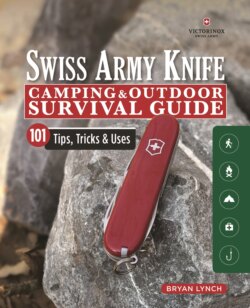Читать книгу Victorinox Swiss Army Knife Camping & Outdoor Survival Guide - Bryan Lynch - Страница 52
На сайте Литреса книга снята с продажи.
Intro to Bushcraft and Survival
ОглавлениеBushcraft has become a popular term to describe someone who uses his or her knowledge and skills to live in the wild. While bushcrafters are using survival skills, typically they are not in a survival situation. For me, bushcraft centers around the ability to sustain yourself long term comfortably by knowing how to construct shelters, furniture, and tools from the surrounding area. A bushcraft situation is one you are prepared for by having the tools you need to complete the tasks at hand (i.e., axe, chisels, saws, and other carving implements). A survival situation is something you’re trying to get out of and are not fully prepared or equipped for. While there are certainly many aspects of bushcraft that apply to a survival situation, they most likely will not be used to the same extent. For example, in a survival situation, not as much time or energy may be spent on building a shelter.
There is also some debate on what a bushcraft knife is versus a survival knife. A knife meant for bushcrafting tends to have a small profile, which makes it better suited for detail work and carving. Generally, a survival knife is thought of as a larger, fixed-blade knife that is capable of digging, cutting, prying, chopping, etc. A survival knife is supposed to do it all because it will most likely be the only tool available.
By my own definition, a Swiss Army Knife is not really a survival knife or a bushcraft knife. Rather, a Swiss Army Knife combines the characteristics of both. However, given the option, if I could have only one tool in a survival situation, I would choose a Swiss Army Knife over a large fixed blade. That is because a Swiss Army Knife can complete more tasks while being safer and saving energy. It will be able to complete finer detail work that is needed in making certain tools and repairing gear.
“For most of history, man has had to fight nature to survive . . . he is beginning to realize that, in order to survive, he must protect it.”
—Jacques-Yves Cousteau
The Swiss Army Knife is arguably the first multi-tool manufactured and has continued to evolve since its simple yet revolutionary conception. It does not do only one thing extremely well, like a single-purpose tool, and this can be frustrating to some. Instead, multi-tools are light-duty tools designed with many attachments to give the user as many options as possible when a toolbox is not available, and thus they may be prone to misuse. Even though they are light-duty tools, they can still complete tough jobs if used properly.
Since I have used a Swiss Army Knife for most of my life, I have never believed the current reality-show lies that we only need one knife and it must be capable of chopping down entire trees or building a small village from logs or defending ourselves from some imaginary force. One of the top reasons I am wary of most of these TV “experts” is because they are using knives that are not really meant for outdoor tasks. When it comes to the detailed work that is involved in camping, hiking, hunting, fishing, and emergency tasks, they just don’t work well. A larger fixed blade has its place, but it works best as a complement to a multi-tool such as the Swiss Army Knife. Together, they create a powerhouse of versatility.
Some of you may read my blog, https://civilizedsurvival.blog/, created to counter the doom-and-gloom culture. I enjoy steering others to good and appropriate tools and techniques through my website, tool reviews, and now this book. My goal was to put a lighter tone to teaching prepping, “old school” skills, DIY projects, natural skills, hunting tips, fishing tips, and emergency preparedness. I don’t want to continue the scare tactics employed by others. Becoming self-reliant should be achieved from the desire to learn and to take care of those you love, not from fear.
In My Experience
Around the age of five or six I received my first pocketknife from my dad. It was a used Swiss Army Knife, but I didn’t care that it wasn’t new. I didn’t use it for several days; I wanted to keep it as it was, perfect. Because my dad had given me one of his tools and trusted me with it, I was proud. Having my own tool, it felt like my first rite of passage. In my young mind, I thought I was finally a man!
The knife became an extension of my body, and I never went anywhere without it. I used it to sharpen sticks, carved letters into pieces of bark, dissected plants, and more. I even tried my hand (unsuccessfully) at whittling. One of my favorite activities was learning how to start fires with the magnifying glass. To my mom’s dismay, many scorch marks found their way onto my shoes and pant legs. After all, I had to test the limits of the greatest tool I had ever owned!
I’m glad to have been among what was surely the last generation for whom it was widely acceptable for a kid to carry a knife. Without a cell phone or a computer (and with video games still being a bit of a luxury), that knife encouraged me to be outdoors and gave me a sense of responsibility at a young age. That first knife instilled in me a lifelong passion (though some might call it an obsession) to always have a good knife on hand. Now, as a dad myself, I have had the pleasure of watching my kids use a Swiss Army Knife as I did when I was a boy.
